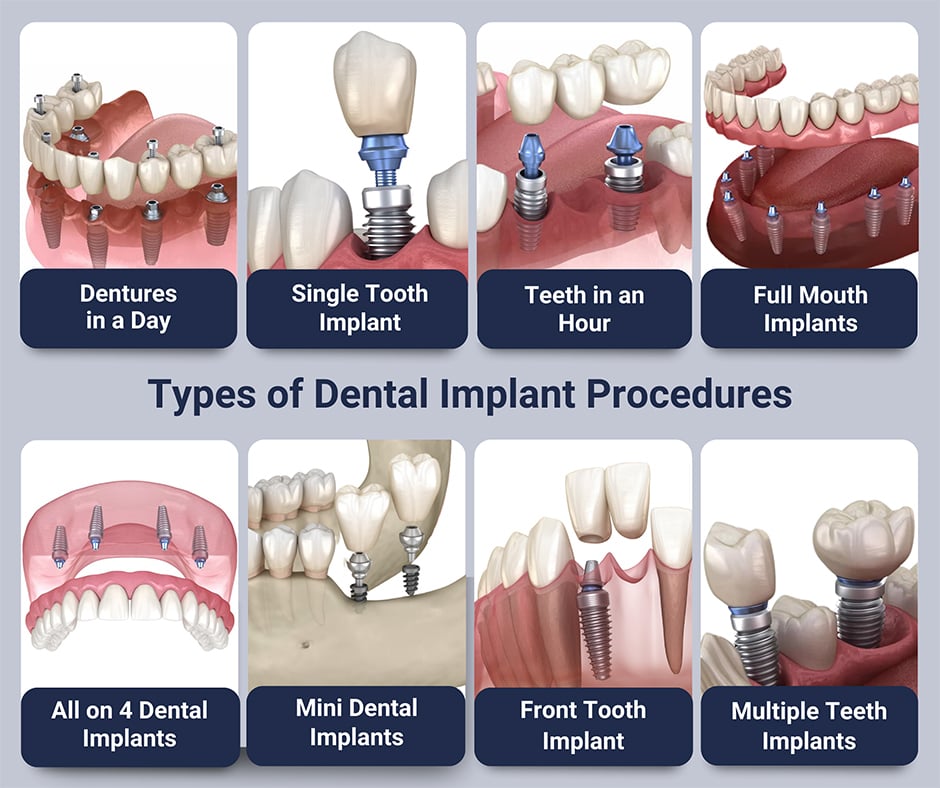Dental Implants for Dummies
Dental Implants for Dummies
Blog Article
The Single Strategy To Use For Dental Implants
Table of Contents9 Easy Facts About Dental Implants DescribedRumored Buzz on Dental ImplantsThe smart Trick of Dental Implants That Nobody is DiscussingIndicators on Dental Implants You Need To Know
are clinical devices surgically dental implanted into the jaw to restore a person's capability to eat or their appearance. They offer assistance for fabricated (phony) teeth, such as crowns, bridges, or dentures. When a tooth is shed as a result of injury or illness, a person can experience problems such as rapid bone loss, malfunctioning speech, or adjustments to chewing patterns that lead to discomfort.
Framework of The Dental Implant System selecting oral implants, talk to your dental supplier about the potential advantages and dangers, and whether you are a candidate for the treatment. Points to consider: Your total wellness is a crucial aspect in determining whether you are a great prospect for dental implants, the length of time it will take to recover, and exactly how long the dental implant may remain in location.
Smoking may affect the recovery process and reduce the long-lasting success of the dental implant. The healing process for the dental implant body might take a number of months or longer, during which time you usually have a short-lived joint in place of the tooth. the dental implant procedure: Meticulously follow the dental health guidelines offered to you by your oral copyright.
Dental Implants Can Be Fun For Anyone
Implant failing can cause the demand for another procedure to repair or replace the implant system. Brings back the ability to eat Restores cosmetic look Assists maintain the jawbone from shrinking due to bone loss Protects the wellness of the surrounding bone and periodontals Assists maintain adjacent (close-by) teeth stable Boosts top quality of life Damages to bordering all-natural teeth during implant positioning Injury to the surrounding tissues throughout surgical treatment, such as sinus perforation Injury during surgical treatment (for example, fracture of bordering jawbone) Insufficient function, such as seeming like the teeth do not bite together normally A sensation that the tooth is loose or turning in place resulting from an abutment screw loosening up Implant body failure (looseness of the implant body) because of systemic infection, which might be more probable in individuals with unchecked diabetics issues because of regional infection in bone and periodontals sustaining the implant body as a result of postponed recovery, which may be more probable in clients who smoke Difficulty cleaning the periodontals around the implant, causing inadequate dental health Unattended gum condition Post-surgical feeling numb as a result of nerve impingement or damages Always inform health and wellness care suppliers and imaging service technicians that you have oral implants before any magnetic resonance imaging (MRI) or x-ray treatments.
FDA is not knowledgeable about any kind of negative occasions reported for MRI or x-ray treatments with oral implants. Dental implants systems are normally made from materials that follow global consensus standards of the International Company for Standardization (ISO) or ASTM International. These standards have information of what makes a risk-free material.
Dental implant systems are evaluated according to worldwide consensus standards. Biocompatibility screening, to reveal that physical call with the gadget does not create problems like irritation or sensitive response, is component of the evaluation that assists make certain the materials in the oral implant system are safe and do not cause unfavorable results when implanted in people.

The Greatest Guide To Dental Implants
Some individuals are not qualified for dental implant surgical treatment. It is for oral doctors to operate on people with: severe illnessuncontrollable metabolic diseasebone or soft cells illness or infectionIf these concerns are fixed, an individual can have the surgical procedure. Dental Implants. In, dental specialists avoid operating people with: If individuals with any one of the above undergo dental implant surgery, there is a higher risk of the implant falling short
Some individuals have a jawbone abnormality that prevents adequate bone for an implant from establishing. In such cases, a cosmetic surgeon might need to do a ridge alteration. This involves lifting the gum to reveal the area of flawed bone. The doctor will certainly after that utilize a bone or bone alternative to repair and build up the area.
Dental dental implant surgery is an individualized process. It's not the same for everybody. However the complying with gives a general introduction of what you can expect your useful site dental professional, oral specialist, periodontist or prosthodontist to do: Put the implant operatively. Give you time to recover. check here Connect the post and last crown, bridge or denture.
Next, your doctor will very carefully place the oral implant into your jaw. Your surgeon will reposition your gums and shut the laceration with stitches (Dental Implants). If your implant is near the front of your mouth, your dentist will certainly make a temporary tooth for you to use till you heal. In this way, you won't have a gap in your smile while you recoup.
Indicators on Dental Implants You Need To Know
Throughout the healing phase, your jawbone should fuse to the oral implant. This process can take anywhere from three to nine months.
As soon as your dental implant heals, your dental practitioner can attach the joint (little connector message) and your final restoration (crown, bridge or denture). This usually takes about one hour to finish and might require a 2nd small surgery. You should not feel any type of pain during your dental implant treatment due to the fact that Read More Here your company will certainly utilize medication to numb your gums.
Report this page